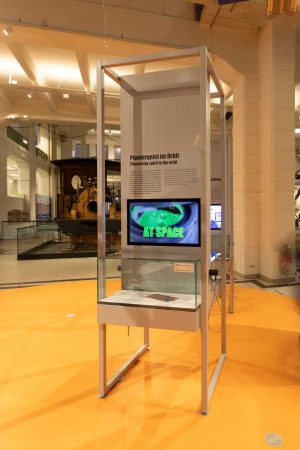Since February 5, 2024, pioneering technologies from the aerospace sector have been on display in the “Innovation Corner” of the Vienna Technical Museum: whether transport drones, satellite cryptography or the latest generation of measuring devices, the “Innovation Corner” gives Austrian start-ups and innovative Projects from technical colleges together with the Lower Austrian technology financing company tecnet equity and the technology incubator accent have a stage.
Eight projects from the aerospace industry exemplify the wealth of ideas of numerous companies and research institutions in an industry that not only contributes to the national economy, but also strengthens Austria's position in global technology competition: interested parties can find out more in the new example of the “Innovation Corner”. Visitors will learn, for example, what the movement of satellites has to do with data encryption, how 3D printing makes it easier to design components in space travel, which instrument protects satellites from damage caused by electrical charges or how the design of a drone determines its payload.
The following aerospace innovations are on display as part of this special format in the Vienna Technical Museum until May 26, 2024:
Satellite Cryptography | St. Pölten University of Applied Sciences
Secure telecommunications requires secure cryptography. To date, only mathematical methods have been used for this purpose; on the other hand, there is a physical method that is based on the reciprocity of radio transmission and the measurement of radio channel properties. The St. Pölten University of Applied Sciences has succeeded in making this technology usable over long distances with the help of the movement of satellites.
Gas distribution and gas pressure dosing system | RHP Space
The gas distribution and gas pressure dosing system from RHP Space is part of the propulsion system that has been used to equip the OneWeb satellite constellation for several years. In space travel, these are usually made up of many different parts, which make the systems very large and unwieldy and require an enormous amount of testing. RHP Space has compressed this structure and replaced it with a 3D block with internal connecting structures, which not least enables a very efficient and cost-reduced technical review.
CLIMB | Wiener Neustadt Aerospace Engineering University of Applied Sciences
The CLIMB satellite project is part of the practical training of the Master's program in Aerospace Engineering at the FH Wiener Neustadt and combines innovative research work and international networking. The aim of the CLIMB mission is to specifically test the electronic components for their radiation resistance in the Van Allen Belt. This is part of the Earth's magnetic field and protects it from high-energy radiation from space, which can be extremely dangerous for the electronics of spacecraft.
Transport drone Trogon | Wiener Neustadt Aerospace Engineering University of Applied Sciences
The Institute for Aerospace Engineering at the FH Wiener Neustadt is working on new concepts for aircraft and their aerodynamics, stability and structural design. The 1:4 scale demonstrator on display is based on the concept of a fast transport drone with a wingspan of 14 meters and a payload of 500 kg, which is intended to achieve a range of 1.500 kilometers at a speed of 300 km/h and has space inside for Euro pallets has.
ASPOC measuring instrument | FOTEC Research and Technology Transfer GmbH
The ASPOC (Active Spacecraft Potential Control) instrument on display from the research company FOTEC at the Wiener Neustadt University of Applied Sciences is used to prevent a satellite from being electrically charged by influences such as UV light or solar wind, which could disrupt or damage the satellite's sensitive measuring instruments. Manufacturing the instrument using 3D printing makes it possible, among other things, to bring together individual parts, eliminating assembly work and reducing weight.
ENPULSION NEO engine | ENPULSION
Field Emission Electric Propulsion produces thrust through ions and an applied electrostatic field. ENPULSION developed the most powerful FEEP engine to date, designed for easy integration into spacecraft. The engine head combines emission surfaces and fuel tanks into a single component and uses non-toxic, non-pressurized indium as the solid metal fuel, allowing the engines to be fully loaded and shipped to customers without special precautions, compared to other space propulsion fuels.
Black Eye | R Space
The start-up R-Space is working to conduct in-orbit demonstration missions (IOD), which are crucial in proving whether a new space technology can withstand environmental conditions such as radiation, heat, cold and vacuum. R-Space's Black Eye concept study aims to collect the crucial technical requirements for the first Austrian satellite specializing in earth observation and reconnaissance and to derive a preliminary design from them.




